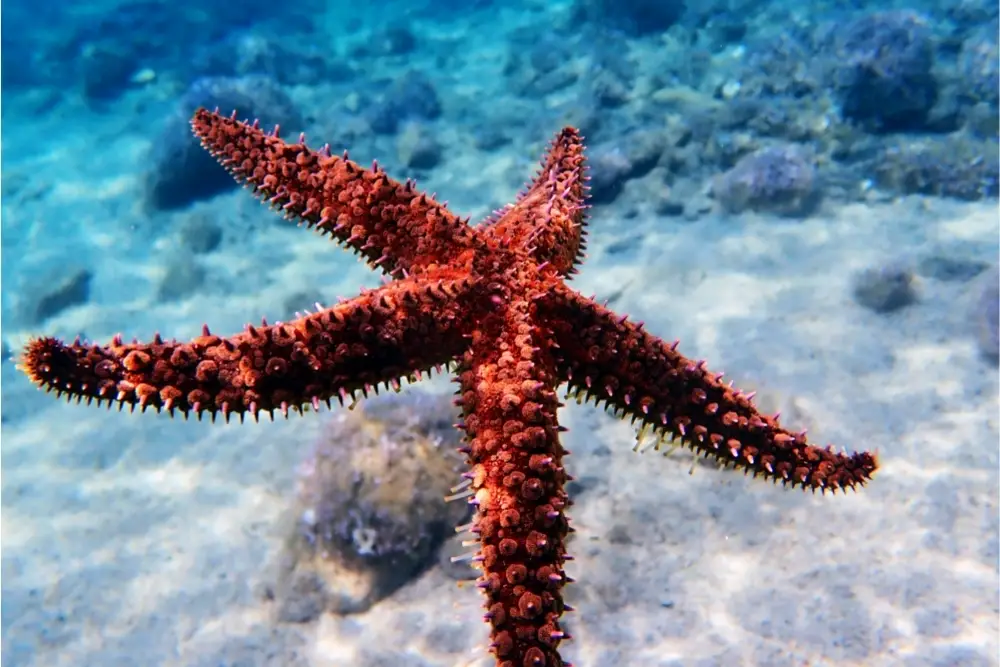We have all stared at the wonder of a starfish before. They are unique, beautiful and strange marine creatures that we love to examine at aquariums, in the ocean and in rockpools.
Sea stars can be found in salt water all over the world from tropical oceans to the cold seafloor, and can come in many different varieties, shapes and sizes.
If you are a marine enthusiast, then you may be interested in understanding or even owning these wonderful creatures yourself, so you will need to know all about them.
In this guide, I will go through exactly what a sea star is, what they eat, how they eat, and how to care for them.
What is a sea star?
A sea star, or a starfish is similar to sea urchins and sea cucumbers as they are all considered to be echinoderms. An echinoderm is a marine invertebrate that has spiny skin, and a hard calcified body that protects them from predators.
Sea stars are star-shaped marine creatures that have lots of tiny tube feet that create a grooved surface on their underside, which allows them to crawl across the ocean floor.
There are roughly about 2,000 different types of Starfish in all of the oceans across the world, with most of them having about 5 arms, but some can have many more.
These strange little creatures have many peculiar traits about them. For instance, they have no brain or bones, can regenerate severed limbs, and have a strange way of consuming their food. So, how do sea stars eat, and what do they eat?
What do sea stars eat?
For the most part, sea stars and starfish prey on mollusks, and are carnivorous creatures. Their diet can consist of clams, oysters, mussels and all different kinds of mollusks that they come across on the bottom of the ocean floor.
Sea stars can actually eat up to 50 small clams in a week, and pry open these shelled fish with their suction cupped feet by themselves.
Starfish have a diet that consists of mollusks mostly because they are easy prey for them to find and eat. Mollusks are incredibly slow moving and are often found attached to rocks and other surfaces along the seafloor, which makes for an easy target for sea stars.
In the Ocean
In their natural habitat, sea stars will prey on mollusks, but also other small pieces of algae and decomposed plants.
Their diets mainly consist of clams, barnacles, coral polyps, decomposed organic matter, mussels, hermit crabs, oysters, plankton, sea urchins, sea snails, seaweed, slow moving fish and even sometimes other starfish.
What sea stars typically eat does depend on the species, and what food sources are available to them depending on their habitat. For instance, a sea star in an aquarium may have a slightly different diet.
In Aquariums
Sea stars that are kept in aquariums need a lot of care and attention, and may not be best for first timers.
They will need a large tank of at least 100 gallons, as they can suffer in environments that are too small, or do not have enough rocky surfaces.
This is why, if you are keeping a Starfish in a tank, you must try to replicate their natural environment as much as possible. In addition, they will need a special diet depending on their natural habitat and species.
Sea stars will consume fish flakes, pellets and other scraps of food that they find on the floor of the aquarium because they are grazers and scavengers. However, they will need a good influx of meaty mollusk in their diet, too.
Therefore, you should make some clams or other mollusks available to them in the tank, if you want them to thrive. However, they will also eat algae that they find in the tank, along with shrimps, prawns and sponges.
Keep in mind that different types of sea stars have different diets, and so you will need to know exactly which species you have before deciding on a specialized diet. In addition, sea stars should be fed every 2-3 days.

How do sea stars eat?
As you may have noticed, a starfish is a peculiar creature indeed. With no visible mouth, or arms, you may be wondering how they catch their prey and consume them.
Sea stars and starfish actually have their mouth and stomach on the underside of their bodies, and use their arms to feel around for food. They can see with their arms, and so this makes it easier to catch prey when crawling the seabed.
A sea star will find prey, and then center it using their arms and feet. When it is close enough to them, the sea star will extend its cardiac stomach out of its mouth, and it will cover the prey and digest it with the stomach.
If a sea star is consuming a mollusk, then they will crack open the shells slightly with their arms, and spit the stomach inside of the shell.
The sea star’s stomach then releases a chemical that works to dissolve the mussel or mollusk, and the sea star will absorb the mollusk’s body.
Once a sea star has absorbed its prey, it will pull the cardiac stomach back into the body, and then will digest its meal in its secondary stomach, the pyloric stomach.
This is how sea stars can prey on things much larger than them, as it absorbs it, digesting the creature outside of its body, and then bringing it back inside to be fully digested and turned into a liquid.






